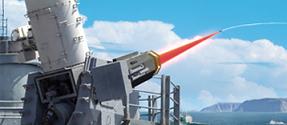Video of Navy Laser Shooting Unmanned Drone Out of the Sky

Share
Look! Up in the sky! It's a bird, it's a plane, it's Supe---ZZZT! Well, whatever it was, it's fried now. The US Navy recently tested a Raytheon infrared laser system by shooting down four unmanned aerial vehicles (UAV) off San Nicholas Island near California. To knock out each UAV, six solid state lasers were controlled by Raytheon's Phalanx, a radar guided gun system that is already used in the field. This 32 kilowatt Laser Phalanx system worked like a charm: four out of four UAV were destroyed over the Pacific. To celebrate, Raytheon shared footage of a UAV being burned out of the sky at the Farnborough Air Show. Check out the video below. Drone killing robot lasers for the win!
They may not look like they're ready for Star Wars, but laser weapons are getting closer to being publicly used in the field. In 2007, Raytheon used a Laser-Phalanx prototype to knock mortar shells out of the air. Boeing had notable success with burning a hole in a truck with an airplane-based laser weapon last year. Now the Navy is knocking down UAVs like flies. Raytheon also announced that they'll be working on a counter measure laser system called Scorpion, an anti-personnel laser (which will "uncomfortably heat" trespassers), and an airport security laser that could take down shoulder launched missiles. While difficult to maintain and considerably more fragile than many projectile systems, laser weapons have superior accuracy and a never ending magazine - as long as you have electricity, you have "bullets". Once they can be perfected, laser systems will augment military defense and offense, hitting high speed targets with lethal amounts of heat and light.
In the following video you can see a plume form as soon as the laser strikes the UAV. The laser light itself is invisible (infrared).
Be Part of the Future
Sign up to receive top stories about groundbreaking technologies and visionary thinkers from SingularityHub.


While the Laser-Phalanx system may seem futuristic, it's basically just two different technologies hacked together: solid state lasers and a robotic gun. The Phalanx system uses a gaitling gun guided by radar to destroy objects moving too quickly for humans to hit. Almost every single US Navy ship operates with a Phalanx on board. Land based versions have been used to counter rockets artillery and mortar (C-RAM) in Iraq's Green Zone. Adding a laser simply takes the robot gun and improves its range and accuracy. Having lethal lasers in the hands of automated systems is a bit unsettling, but considering we already let them use machine guns I'm not too worried.
The Navy's duck hunting test with lasers and UAVs was pretty impressive, but it's likely to take several years before a system like the Laser Phalanx could make its way into mass production. By that time, it's importance could increase drastically. The US military relies heavily on drones for reconnaissance and tactical strikes, but terrorist groups use their own drones to spy on US ships and bases. In five years or so, you can expect that such groups will have many more armed drones, and will also perform quick mortar strikes when the drone locates US soldiers. Having a laser system that can knock down both drones and mortars is going to come in helpful. And hopefully, one day, all this war bullsh*t will be over with and we can focus on using technology to save people's lives. I already have a job lined up for all the retired military lasers: mosquito hunting.
[image and video credits: Raytheon]
[source: Raytheon, Raytheon VP Mike Booen via Aviation Week]
Related Articles

AI Companies Are Betting Billions on AI Scaling Laws. Will Their Wager Pay Off?

Are Animals and AI Conscious? Scientists Devise New Theories for How to Test This

Is the AI Bubble About to Burst? What to Watch for as the Markets Wobble
What we’re reading
